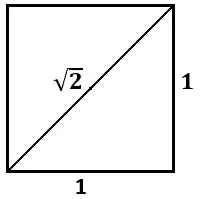Linear algebra (Osnabrück 2024-2025)/Part II/Lecture 47
- Commensurability

Two line segments und
are called commensurable, if there exists a line segment with the propery that both line segments are integer multiples ofReal numbers are called commensurable if is a
rational number.This is the equivalence relation for the subgroup
in the sense of definition.
The question, whether there exist, beside the rational numbers, further useful numbers, has its roots in ancient Greece. The question was raised in the form whether two lengths, given in a natural way, are always commensurable to each other (whether there exists a third length such that the two given lengths are integer multiples of it). The Pythagorean school believed in the harmony of the universe, and this implied that all proportions between natural lengths must be expressed by a proportion of integer numbers. They found such integer proportions in music (music intervals), and thought that such proportions hold for the motions of the planets, and for geometry in general. Some people speculate that they knew the reasoning of Fact ***** showing the irrationality of (the incommensurability of the side length and the length of the diagonal in a square), but that they concealed this knowledge. Anyhow, later in ancient times the knowledge was accepted that there are irrational numbers.
The subgroup relation
(which might be considered as a relation of a linear subspace of -vector spaces) yields also an equivalence relation on the real numbers. Here, two real numbers are equivalent if their difference is a rational number.
- Homomorphism theorems
Let and be groups, and let be a group homomorphism and a surjective group homomorphism. Suppose that
ist. Then there exists a uniquely determined group homomorphism
such that holds. Put differently, the diagram
We show firstly the uniqueness. For every Element , there exists some with . The commutativity of the diagram ensures that
holds. This means that there exists at most one .
We have to show that this condition yields a well-defined mapping. Hence, let be two preimages of . Then
therefore, we have . Hence, , and the mapping is well-defined. Let be given, and let be preimages. Then is a preimage of . Therefore,
This means that is a group homomorphism.
We consider the surjective group homomorphisms
and
We have
Due to Theorem 47.4 , there exists a uniquely determined group homomorphism
which is compatible with the remainder mappings. The morphism sends the remainder of a number after division by to the remainder after division by . In particular, the theorem implies that the second remainder does only depend on the first remainder, not on the number itself.
If, to the contrary, we consider
and
then
and there does not exists a natural mapping
For example, the numbers have modulo the remainder but modulo their remainders are .
The mapping constructed in this theorem is called induced mapping or induced homomorphism, and the theorem is called the theorem about the induced homomorphism.
Let and be groups, and let
be a surjective group homomorphism. Then there exists a canonical isomorphism
We apply Theorem 47.4 to and the canonical projection . This induces a group homomorphism
fulfilling , which is surjective. Let and . Then
Therefore, . Hence, , that is, the kernel of is trivial, and so, due to Lemma 44.22 , is also injective.
Let be a cyclic group with a generator . We consider the corresponding group homomorphism
in the sense of Lemma 44.12 . Since we have a generator, this mapping is surjective. The kernel of this mapping is determined the order of , which we denote by (or it is , in case the order is ). Due to Corollary 47.6 , there exists a canonical isomorphism
In particular, there exists, up to isomorphism, for every , exactly one cyclic group, namely .
is surjective. Due to the periodicity of the trigonometric functions, the kernel equals . By the isomorphism theorem, there exists a canonical isomorphism
The complex exponential function
is a surjective group homomorphism. The kernel is . Due to the isomorphism theorem, there exists a canonical isomorphism
The determinant
is a surjective group homomorphism; its kernel is by definition the special linear group . Due to the isomorphism theorem, there exists a canonical isomorphism
Let and be groups, and let
be a group homomorphism. Then there exists a canonical factorization
where is the canonical projection, is a group isomorphism, and is the canonical inclusion of the
image group.This follows from Corollary 47.6 , applied to the image group .
This statement is often briefly expressed by saying:
image preimage modulo kernel.
Let be a group, and let be a normal subgroup with residue class group . Let be another normal subgroup in with . Then the image of in is a normal subgroup, and we have a canonical isomorphism
For the first statement, see Exercise 46.19 . Therefore, the residue class group is well-defined. We consider the composition
Because of
we have . Hence, according to Corollary 47.6 , we get the canonical isomorphism
In short, we have
- Residue class space
Let be a field, let be a -vector space, and let denote a linear subspace. Then the relation given by
is an equivalence relation
on .
We give another direct proof that we have an a equivalence relation.
We look at the conditions of an equivalence relationn The reflexivity follows from , the symmetry follows from . The transitivity follows like this: from and , we infer .

The cosets of a linear subspace have a simple geometric interpretation: a coset is nothing but an affine subspace of that is parallel to , that is, a space of the form with . The quotient set is the set of these affine subspaces.
We may apply to this equivalence relation the general results for a normal subgroup in a group and the corresponding equivalence relation, and we obtain a surjective quotient mapping (or identifying mapping, or canonical projection)
instead of , we shall write . An extra feature in this situation is that this quotient set is itself a vector space, and that the canonical mapping is linear.
Let be a field, let be a -vector space, and let denote a linear subspace. Let be the set of all equivalence classes (the quotient set) of the equivalence relation on defined by , and let
denote the canonical projection. Then there exists a uniquely determined structure of a -vector space on such that is a
-linear mapping.The existence and uniqueness of the group structure on , and the homomorphism property of the projection, follow from Theorem 46.14 . For the projection to be linear, the scalar multiplication must satisfy
We have to show that by this condition, a well-defined scalar multiplication on is given. Let , with . Then we have
and the is equivalent to . The well-definedness of the scalar multiplication on and the surjectivity of the mapping imply that we have a vector space structure, and that the mapping is also compatible with the scalar multiplication.
Let be a field, let be a -vector space, and let denote a linear subspace. Then the set of all equivalence classes, together with the structure of a vector space as proven in Theorem 47.14 , is called the residue class space (or quotient space)
of modulo .Let be a field, and let and denote vector spaces over . Let be a linear mapping, and be a surjective linear mapping. Suppose that
holds. Then there exists a uniquely determined linear mapping
fulfilling . In other words: the diagram
The statement about existence and uniqueness follows from Theorem 47.4 . We have to show that the uniquly determined group homomorphism is also compatible with scalar multiplication. Let be given with a preimage , and let . Then is a preimage of ; therefore,
and is also compatible with the scalar multiplication.
The mapping constructed in the preceding theorem is called the induced linear mapping; accordingly, the theorem is also called the theorem about the induced mapping.
Let be a field, and let
denote a surjective linear mapping between -vector spaces. Then there exists a canonical linear isomorphism
This follows from Corollary 47.6 and Theorem 47.16 .
Let be a field, and let
be a linear mapping between -vector spaces. Then there exists a canonical factorization
where is the canonical projection, is a vector space isomorphism, and is the canonical inclusion of the image space
in .This follows from Corollary 47.17 , applied to the surjective linear mapping
This statement can be briefly formuluated as:
Image preimage modulo kernel.
Let denote a field, and let denote a finite-dimensional vector space. Let be a linear subspace. Then
Let be a field, and let denote a -vector space, together with a direct sum decomposition
with linear subspaces and . Then
| << | Linear algebra (Osnabrück 2024-2025)/Part II | >> PDF-version of this lecture Exercise sheet for this lecture (PDF) |
|---|